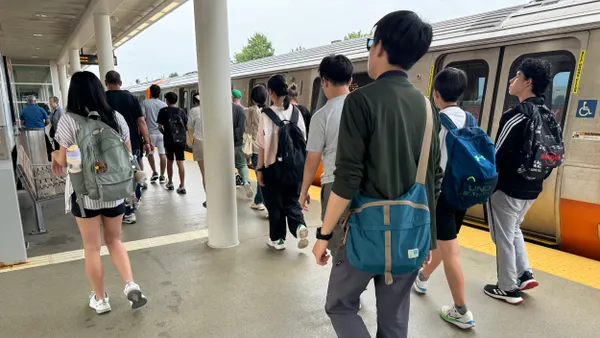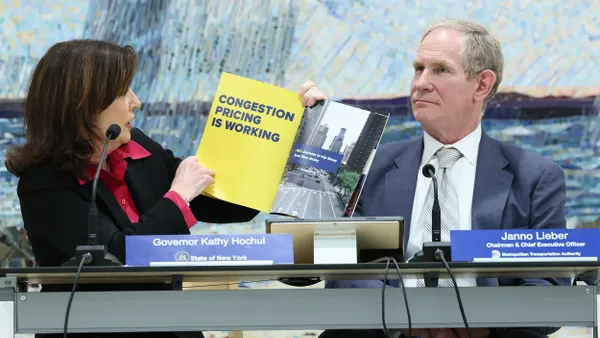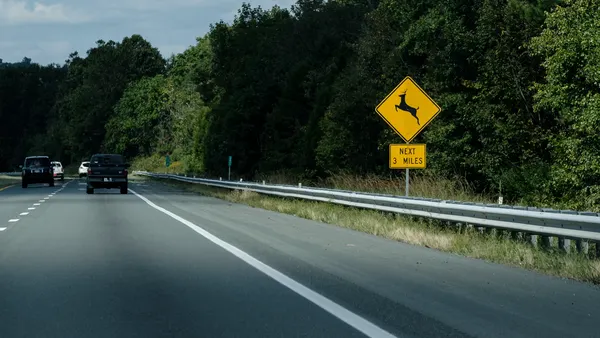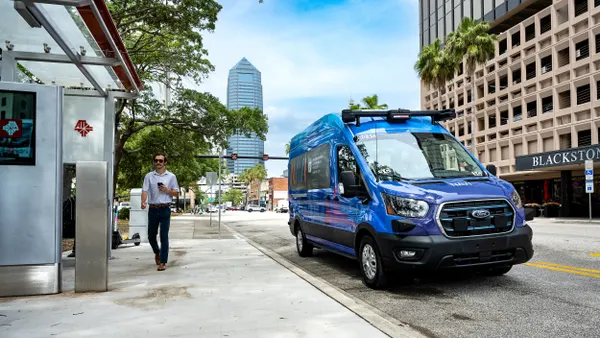Dive Brief:
- Uber on Monday launched a city mobility campaign focused on infrastructure and improving safety for vulnerable roadway users such as bicyclists, scooter riders and pedestrians. Along with co-signatories PeopleforBikes, the North American Bikeshare Association and the League of American Bicyclists, the company sent a letter to the U.S. House of Representatives Committee on Transportation & Infrastructure requesting additional funding for infrastructure to protect pedestrians and mobility device users.
- Uber also is publicly releasing a free data tool in its Uber Movement platform that shows Jump bike volume within a city, starting with San Francisco, Washington, DC and Paris. The tool will show where bikes and scooters are used most to inform cities' decisions about where infrastructure opportunities exist.
- "We would love to have more people choose bicycles and scooters, and that's really only possible if infrastructure is there to enhance safety. We're obviously not an infrastructure-building company, [but] we would love to help cities be in a position to be able to do that more frequently," Shin-pei Tsay, director of policy, cities & transportation for Uber, told Smart Cities Dive.
Dive Insight:
As mobility companies become more established and their presence grows nationwide, they have pushed for expanded and renovated infrastructure to better serve their customers. Some companies have tried to directly help cities by funding the upgrades; Bird had a fund to help cities pay for mobility infrastructure such as protected bike lanes, but the company shut down that program after about a year due to an alleged misuse of funds.
Uber's strategy is different because it reduces its own risk by not directly contributing funds. Instead, it engages in advocacy with the letter to Congress, and enables cities to plan the best places for their enhancements via the bike data tool.
Uber already provides Jump bike data to many cities that request it to fulfill operating license requirements, and it launched a Jump bike platform for city program managers more than a year ago. But the new tool makes the data available to the public as well.
It will help users see where Jump bikes travel the most frequently and in the highest volume. If bike lanes do not already exist in those areas, the volume data could influence the locations where city planners may invest in lane installation. It could also signal areas where traditional bike lanes could be improved with features such as barriers between cyclists and traffic.
"Often with transportation planning it's hard to tell where you should be putting in infrastructure, and you have to make trade-offs in terms of where to go first. We wanted to show cities and advocacy organizations where exactly people are using bikes," Tsay said.
By letting citizens use the portal to see the most heavily-traveled routes, Uber suggests it could also drum up greater public support for infrastructure improvements.
Cities recently have put more emphasis on improving transportation infrastructure. For example, San Francisco Mayor London Breed announced a plan last year to upgrade and expand the city's bike lane network.
Some of the changes stem from public pressure to make streets safer and more accessible for non-vehicular users. Washington, DC lawmakers introduced legislation to make protected bike lane installations mandatory on roads that are being repaired following a cyclist's death. And New York Mayor Bill de Blasio unveiled an extensive bike safety plan that includes infrastructure improvements amid an uproar over a rash of cyclists killed on city streets.
In 2019, New York experienced its deadliest year for cyclists in nearly two decades, with 29 deaths.
Last fall, the National Transportation Safety Board even recommended that cities and states invest in better cycling infrastructure when it released its first report on cyclist safety in 47 years. It offered 23 findings and a dozen safety recommendations, including implementing protected bike lanes.










